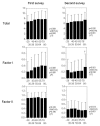Factor structure of the General Health Questionnaire (GHQ-12) in subjects who had suffered from the 2004 Niigata-Chuetsu Earthquake in Japan: a community-based study
- PMID: 17650342
- PMCID: PMC1939990
- DOI: 10.1186/1471-2458-7-175
Factor structure of the General Health Questionnaire (GHQ-12) in subjects who had suffered from the 2004 Niigata-Chuetsu Earthquake in Japan: a community-based study
Abstract
Background: Factor structure of the 12-item General Health Questionnaire (GHQ-12) was studied by a survey of subjects who had experienced the 2004 Niigata-Chuetsu earthquake (6.8 on the Richter scale) in Japan.
Methods: Psychological distress was measured at two years after the earthquake by using GHQ-12 in 2,107 subjects (99.0% response rate) who suffered the earthquake. GHQ-12 was scored by binary, chronic and Likert scoring method. Confirmatory factor analysis was used to reveal the factor structure of GHQ-12. Categorical regression analysis was performed to evaluate the relationships between various background factors and GHQ-12 scores.
Results: Confirmatory factor analysis revealed that the model consisting of the two factors and using chronic method gave the best goodness-of-fit among the various models for factor structure. Recovery in the scale for the factor 'social dysfunction' was remarkably impaired compared with that of the factor 'dysphoria'. Categorical regression analysis revealed that various factors, including advanced age, were associated with psychological distress. Advanced age affected the impaired recovery of factor 'social dysfunction' score as well as total GHQ score.
Conclusion: The two-factor structure of GHQ-12 was conserved between the survey at five month and that at two years after the earthquake. Impaired recovery in the ability to cope with daily problems in the subjects who had experienced the earthquake was remarkable even at two years after the earthquake.
Figures


Similar articles
-
Impaired psychological recovery in the elderly after the Niigata-Chuetsu Earthquake in Japan:a population-based study.BMC Public Health. 2006 Sep 14;6:230. doi: 10.1186/1471-2458-6-230. BMC Public Health. 2006. PMID: 16970828 Free PMC article.
-
Factors impacting on psychological distress and recovery after the 2004 Niigata-Chuetsu earthquake, Japan: community-based study.Psychiatry Clin Neurosci. 2008 Oct;62(5):503-7. doi: 10.1111/j.1440-1819.2008.01842.x. Psychiatry Clin Neurosci. 2008. PMID: 18950368
-
Using the 12-item General Health Questionnaire to screen psychological distress from survivorship to end-of-life care: dimensionality and item quality.Psychooncology. 2012 Sep;21(9):954-61. doi: 10.1002/pon.1989. Epub 2011 May 9. Psychooncology. 2012. PMID: 21557386
-
[Evaluation of the middle and long term health care effects of the Hanshin Awaji earthquake in Kobe, Japan].Med Clin (Barc). 1999 Oct 23;113(13):496-504. Med Clin (Barc). 1999. PMID: 10604176 Review. Spanish. No abstract available.
-
Confirmatory factor analysis of the GHQ-12: can I see that again?Aust N Z J Psychiatry. 2003 Aug;37(4):475-83. doi: 10.1046/j.1440-1614.2003.01208.x. Aust N Z J Psychiatry. 2003. PMID: 12873334 Review.
Cited by
-
Prevalence of mistreatment or belittlement among medical students--a cross sectional survey at a private medical school in Karachi, Pakistan.PLoS One. 2010 Oct 15;5(10):e13429. doi: 10.1371/journal.pone.0013429. PLoS One. 2010. PMID: 20976173 Free PMC article.
-
Mental health of nurses after the Fukushima complex disaster: a narrative review.J Radiat Res. 2018 Apr 1;59(suppl_2):ii108-ii113. doi: 10.1093/jrr/rry023. J Radiat Res. 2018. PMID: 29668971 Free PMC article. Review.
-
Cross-cultural measurement invariance of the General Health Questionnaire-12 in a German and a Colombian population sample.Int J Methods Psychiatr Res. 2017 Dec;26(4):e1532. doi: 10.1002/mpr.1532. Epub 2017 Feb 1. Int J Methods Psychiatr Res. 2017. PMID: 28147466 Free PMC article.
-
Disease Severity, Quality of Life, and Psychiatric Morbidity in Patients With Psoriasis With Reference to Sociodemographic, Lifestyle, and Clinical Variables: A Prospective, Cross-Sectional Study From Lahore, Pakistan.Prim Care Companion CNS Disord. 2015 Jun 25;17(3):10.4088/PCC.14m01629. doi: 10.4088/PCC.14m01629. eCollection 2015. Prim Care Companion CNS Disord. 2015. PMID: 26644955 Free PMC article.
-
An Assessment of the Psychometric Properties of the GHQ-12 in an English Population of Autistic Adults Without Learning Difficulties.J Autism Dev Disord. 2021 Apr;51(4):1093-1106. doi: 10.1007/s10803-020-04604-2. J Autism Dev Disord. 2021. PMID: 32653976 Free PMC article.
References
-
- Goldberg D. The Detection of Psychiatric Illness by Questionnaire: A Teqnique for the Identification and Assessment of Non-Psychiatric Illness. Maudsley Monograph No 21, London, Oxford University Press. 1972.
MeSH terms
LinkOut - more resources
Full Text Sources
Medical

